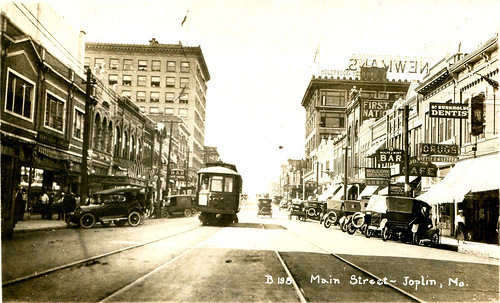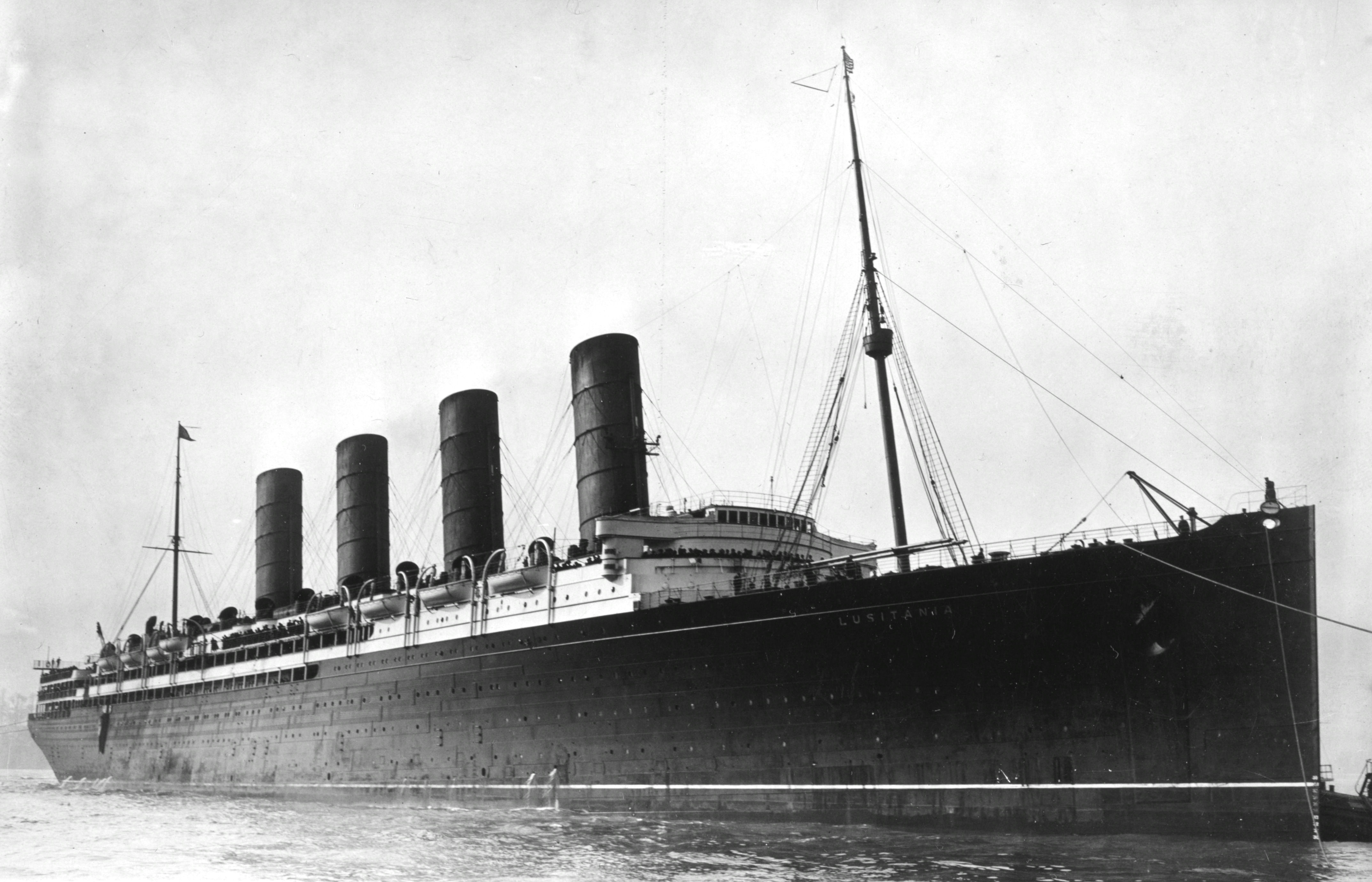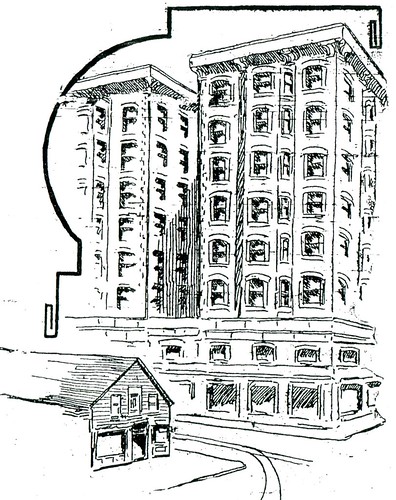The next building in the Alfred W. Rea portfolio series is the A. Hafley Building of Monett, Missouri, built in 1905 at a cost $4,500, which in today’s money would roughly be $90,000 to $100,000. Unfortunately, we were unable to conduct in-depth research on this particular building, but we can happily inform you that the building still stands (or did recently!) next to the parking lot at the corner of East Broadway and 3rd Street.
The Architectural Legacy of Garstang & Rea: A. Hafley Building of Monett, Missouri
I Love You Honey, I Love Your Money, I Love Your Automobile
In 1911, G.B. Fout published the Missouri State Automobile Directory and Guide. Compiled from information provided by the Missouri Secretary of State’s office, the guide listed the names of automobile owners, their state license numbers, and the make of their car. Published at the dawn of the age of the automobile, its pages list a wide variety of automobile brands, many of whom vanished decades ago. Unfortunately, the actual model of the automobile was not listed. A snapshot in time, this provides a glimpse of the early autos of Joplin and those who were fortunate enough to own one.
Here is a small sampling of some of Joplin’s automobile owners:
Local capitalist A.H. Rogers owned both a Stevens Duryea and a Packard. Charles Schifferdecker, who also owned two cars, preferred a Pope Waverly and a Rambler. Freeman Foundry owner J.W. Freeman drove an REO while architect A.C. Michaelis had a Reliable Dayton. Baker Albert Junge and “Father of Missouri’s Good Roads” John M. Malang, men after our own hearts, cruised the streets in a Cadillac. Junge also owned a creatively named Hupmobile. Dr. Samuel A. Grantham relied on a Buick and a Pennsylvania for his transportation needs. Edmund A. Bliedung, manager at Christman’s Department Store, was the only Joplin resident to drive a Babcock Electric Car. Former Joplin Globe owner Gilbert Barbee chose the short lived Speedwell. Mrs. Effie L. Snapp, the only woman listed, was the proud owner of a Chelsea.
Three Joplin residents owned cars made in St. Louis, Missouri. S.L. Wilkins was the only individual in Joplin who owned a Moon motor car. Founded in 1905, the company went out of business during the Great Depression. E.A.C. Elliott was the only Joplin resident who drove a St. Louis which was, as the name indicates, also manufactured in St. Louis, Missouri. Established in 1898, St. Louis Motor Carriage Company was defunct by 1907. Very few examples of this car still exist, but one can be found in the collection of the Museum of Transportation in St. Louis, Missouri. J.J. Anderson putted around in a Dorris
Local businesses were also listed. Both the Thomas Fruit Company and Interstate Grocery Company owned a Rapid, the Empire District Electric Company used an Empire, and the H&H Taxicab Company picked up customers in a short-lived EMF. The United Mining Company, Du Pont Powder Company, United Iron Works Company, Empire Zinc Company, Excelsior Zinc and Lead Company, and Howard & Brown all used Buicks. The Joplin Hay Company used an Overland to deliver orders to customers. The Independent Candy Company owned two Internationals. The Joplin Sludging Company drove an Oakland.
Unfortunately, it does not appear that G.B. Fout published subsequent editions of his directory, leaving us to wonder what automobiles succeeded their earlier counterparts on the rough streets of Joplin.
Elliot Raines Moffett
On a fall day six years after the end of the Civil War, two men began digging a shaft on a hill near Joplin Creek in southern Jasper County, Missouri. Lured to the location by stories of lead lying as shallow as the roots of the prairie grasses, the two men, Elliot Raines Moffett and John B. Sergeant struck figurative gold and from those first few spadefuls of dirt the city of Joplin was established, as well their riches.
A native Iowan, Moffett was forty-three years old when his prospecting brought him to Jasper County. He and Sergeant had initially setup in the area of Oronogo, then known as Minersville, and acquired a mining interest in the vicinity of land owned by John C. Cox, a Tennessean who had arrived in the area years earlier. The lead strike, forty feet down, quickly led Moffett and Sergeant to build the first lead smelting furnace north of present day Broadway and on the banks of Joplin Creek. The smelter was not the only “first” that Moffett and his partner brought to the mining camp and later the city. In 1873, when the cities of Joplin and Murphysburg joined together to form Joplin, Moffett was the first mayor. In addition to building stores in the fledgling camp, he and Sergeant also opened one of the first banks at 315 Main Street and founded the Joplin & Girard Railroad completed in 1876 to connect the growing lead furnaces of the city to the Kansas coal fields. A second railroad to Pittsburg, Kansas, was completed and celebrated on July 4, 1876 with a golden spike driven into the earth at the Joplin depot. Later, Moffett sold his interest in the railroad and its right-away southward to the St. Louis and San Francisco Railway, also known as the Frisco, for a hefty $350,000. Not long after, Sergeant and Moffett opened up the White Lead Works which later became known as the Picher Lead Works.
It was prospecting which brought Moffett to the Joplin area, it was also that which led him to leave for Northwest Arkansas. In the belief that more incredible lead veins were waiting to be discovered in Arkansas, he prospected the hills around Bear Mountain. He found some lead, but not enough to make a second fortune. Instead, Moffett purchased hundreds of acres of land and went into the business of fruits and grapes. It was as a shepherd of orchards that Moffett spent the last years of his life until he passed away in February, 1904, in Crystal Springs, Arkansas.
Upon his death, one Joplin newspaper wrote of him:
“The announcement of his death spread rapidly over the city yesterday evening and many sincere expressions of regret were voiced, and the utterances were of that sincere character that indicate true regret – the regret that is always felt at the demise of a truly good citizen. The reason of this is very apparent when it is known that he was instrumental in building the first schools and the first churches, and was a willing contributor to many movements for the city’s welfare.”
The Devil of East Joplin
Back one hot August summer in the 1920s, the Devil roamed the streets of East Joplin. A number of women and children reported a tall figure that resembled Beelzebub jumping out of the darkness at them and then running away. Mrs. W.H. Longacre watched in horror as a satanic figure ran in front of her car as she drove her children home. Mrs. Longacre’s report to the police went unheeded.
Doors were locked, windows were barred, and a small group of East Joplin men prowled the streets with their shotguns loaded. Rumors swirled as to whether or not it really was Old Scratch or just some harmless prankster. Some believed it was a prankster who wore armor underneath his costume to keep him safe from harm. After it became known that men were searching for the Devil armed with shotguns, Vard I. Cowan, a laborer for the Southwest Missouri Railroad Company, confessed to playing tricks on unsuspecting victims. He had used it at a church party earlier in the year and had such a good time that he continued to play tricks on residents the rest of the summer.
Some expressed their belief that Cowan’s antics were connected to the nearby Nazarene Church, but the pastor, Rev. F.C. Savage, denied that he or the church was involved with Cowan’s mischief. Mrs. Cowan, meanwhile, declared, “He has quit it. We don’t want to get into trouble.”
There were no further reports of the Prince of Darkness lurking on the streets of East Joplin.
Murder in the Bottoms
Since Joplin first began as a rough mining town on the edge of the Ozarks, it has seen its share of violence, though many of the crimes have long since been forgotten. In the spring of 1899, the Joplin Daily News trumpeted, “The most startling discovery in crime ever known in the annals of Joplin was made about noon today at a tent in the Kansas City Bottom[s] near the mouth of St. Joe Hollow. Five persons were found dead and their bodies are in a horrible state of decomposition.”
According the news account, two young boys, Mack Hutchinson and Walter Towsley, were in the area when they noticed swarms of flies and a strong stench in the air. They followed the smell to a tent 8×12 in size. What they found was horrifying: “the headless body of a baby on the outside, and on peering inside they discovered the dead bodies of two more children, a man and a woman.” After alerting authorities, a large crowd gathered around the tent, where further investigation showed that the man, James Moss, had bludgeoned his wife and two of his children to death before beheading a third child. He then shot himself with a .38 revolver.
Interviews with neighbors revealed the family had been in the Joplin area for around two months and that the father, James Moss, had worked “scrapping ore.” No one the News reporter spoke to had heard the gunshot or any sounds of a struggle even though their closest neighbor lived only 150 feet away from the Moss family tent. The reporter later encountered two women who claimed that they had heard a single gunshot on a Tuesday evening, but thought nothing of it. The scene, it later was learned, was “within a stone’s throw of the old pump shaft where Lewis Channell was killed by Charley Seaton a number of years ago.” The bodies were claimed by the coroner and taken from the scene.
Examination of the Moss’ belongings revealed a few details about the family. The Moss’ originally hailed from Independence, Missouri. James E. Moss was 35 years old and was a former stagecoach driver between Deadwood and Bismarck, North Dakota, up to 1881. He also worked as a driver for the Emery, Bird, & Thayer department store in Kansas City. It later appeared that Moss, his wife Ida, and his children had lived for a brief time in Los Angeles, California, before heading back east to Missouri. The News reporter remarked James’ possessions showed that he “was somewhat of a misanthropist, judging from some of his writings, and was a reader of Tom Paine.” Moss owned copies of Paine’s Age of Reason and Rights of Man that “appeared to have been read considerably.” The reporter mused, “He probably became despondent and sore on the world, and while in that mood murdered his family and then ended his own life.” The only money found was $1.25.
The Kansas City Journal observed, “Moss was an ardent admirer of Robert G. Ingersoll, especially of his views on suicide, and being a man of intense convictions relative to this and other religious views, it is believed here that he was crazy.” A single note was discovered at the scene of the crime, written in Moss’ hand, which read, “There was no truer wife nor lovelier children than mine. J.E. Moss.”
A few days after the murders occurred, Ida Moss’ brother and half -sister arrived to collect the family’s belongings and shipped them to Independence. The tent, bedding, and other items that remained were then burned. The bodies of the family were to be sent back to Independence within the year for burial. The murders were eventually forgotten over time, but remain one of the grisliest to occur in Joplin’s history.
Guest Piece: Joplin’s Black History – Leslie Simpson
The history of Joplin from the point of view of its black population has been difficult to trace. People are probably aware that Langston Hughes was born in Joplin, but his family left when he was still an infant. There was also the infamous lynching episode and subsequent flight of black citizens in 1903. But what about those who stayed, worked, raised their children, and died in Joplin? What were their lives like?
The earliest black inhabitants of southwest Missouri were, obviously, slaves belonging to the first white settlers. The 1850 slave schedule for Jasper County listed 212 slaves, including 3 belonging to John C. Cox, who later established the town of Joplin. There were 166 slaveholders registered in the county in 1861. Slaves were itemized on county probate records and deed transfers as well. It is heart-rending to read some of these documents. For instance, there is the account of an entire family (Sarah, Mary, Henry, Lewis, Susan, and Matilda) being sold for $1 and of three “copper-colored slaves” given to Arabella Sanders by her mother Margaret as a gift.
What happened to these people after they were freed? How did they earn a living? The 1870 census reveals the few occupations that were available to them–mill work, farm labor, and housekeeping. The mining boom, which put Joplin on the map in 1872, gave the freed slaves many more options. The 1880 census indicates that they held jobs in hotels, butcher shops, saloons, laundries, livery stables, in addition to doing farm and domestic work. They also worked in the mines. In fact, some were even mine owners! The Black Seven mine was owned by seven black men.
Joplin’s population grew from 9,943 in 1890 to 26,023 in 1900. Business was booming, and there was work for all. The 1900 census reveals an interesting trend. In addition to the previously noted occupations held by blacks, there were also more skilled professions listed–teacher, preacher, physician, barber, stone mason, plasterer, coachman, ice man, carpenter, taxi driver, grocer, upholsterer, and woolen mill, to name a few. But this trend did not last, probably due to the Great Depression and to the end of the mining era. In the 1937 Negro City and County Directory the majority of Joplin’s black citizenry were porters, domestic workers, and janitors. The only black-owned businesses were a dry cleaner, shoe shine parlor, barber shop, shoe repair shop, and a boarding house.
Speaking of 1937, the introduction to the Joplin city directory for that year, written by the Chamber of Commerce, enthuses that “The population is almost entirely white and almost entirely composed of intelligent, native stock, thereby eliminating the chief source of recurrent labor troubles.”
These are merely observations based upon a few historic documents. The black history of Joplin has yet to be written.
Leslie Simpson, an expert on Joplin history and architecture, is the director of the Post Memorial Art Reference Library, located within the Joplin Public Library. She is the author of From Lincoln Logs to Lego Blocks: How Joplin Was Built, Now and Then and Again: Joplin Historic Architecture. and Joplin: A Postcard History.
Joplin Charity
Joplin has benefited from the charity of many over the past year since May, 2011. More than a century ago, Galveston, Texas, was virtually wiped out by a hurricane that claimed 6,000 to 12,000 lives. When that city was struck by a natural disaster, Joplin stepped forward in 1900 and offered over $25,000 to the beleaguered city, a sum close to $646,348.57 in 2010 dollars.

A Fireman from Joplin’s Past
Today’s post is a glimpse at one of Joplin’s earliest firemen. As previously covered on Historic Joplin, the Joplin Fire Department came into existence in the mid-1870s. Below is an unidentified fireman of the era who helped protect the young city of Joplin from the dangerous threat of fire.
A Slice of Old Joplin
From the recollection of Bud Belden in Pioneering Days, we get a glimpse at one of the tastier elements of Joplin’s past:
“Mr. E.E. (Jimmy) Denham owned the Hub and where ever hangs the Denham sign good fellows congregate. The roast beef at the Hub was something to write home about. Jimmy had an attendant who served it at all hours. Small portions of roast beef Au Jus sliced thin by the attendant who dipped each juicy morsel in natural gravy before placing it on a slice of rye bread you held extended in your left hand. Then you tenderly pressed the top slice in place and you had a sandwich of which the Angel’s sing. The sandwiches were delicious and they were free. How gladly we would exchange our gold for them today.”
Ernest E. Denham’s “The Hub” was located at 103 East Fourth in Joplin, Missouri. He later operated the Rex Billiard Parlor.











